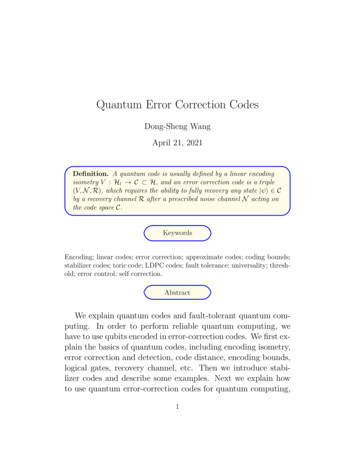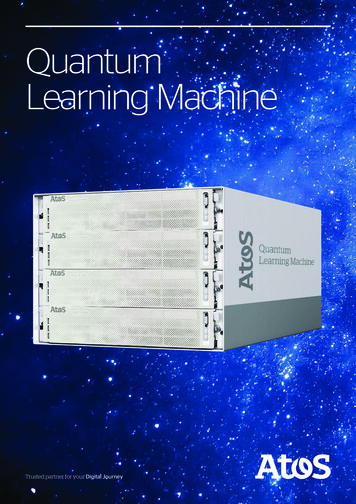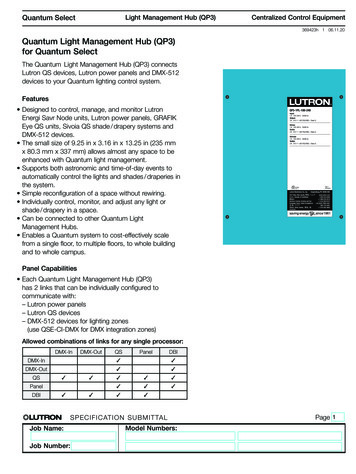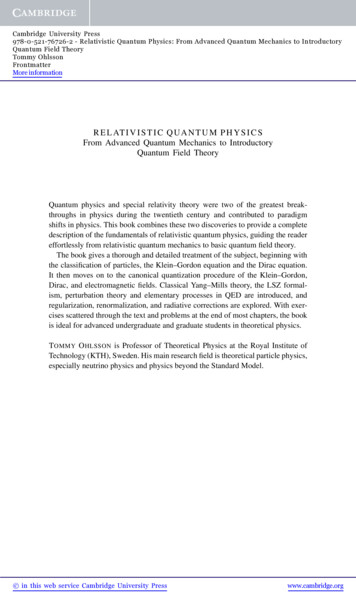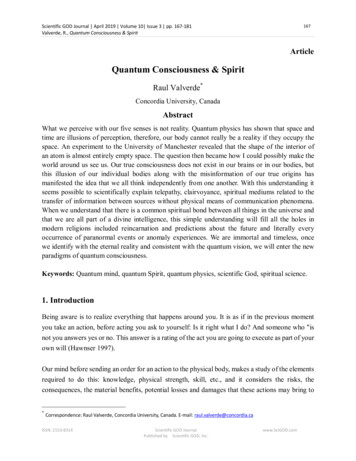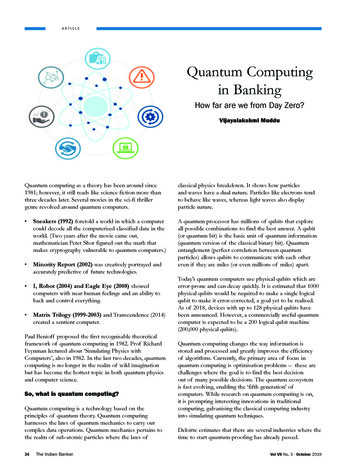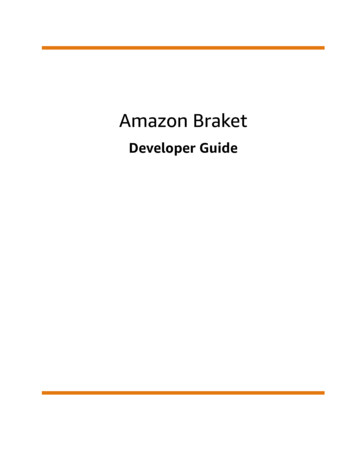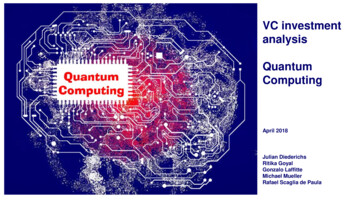
Transcription
VC investmentanalysisQuantumComputingApril 2018Julian DiederichsRitika GoyalGonzalo LaffitteMichael MuellerRafael Scaglia de Paula
Table of contentsQC technology explainedQC player landscapeSuccess criteria1Technology7Corporate space13Success criteria2Brief history8Academic space14Key success factors offunded QC startups3Recent breakthroughs9Global VC activity4Current challenges10Global startup space5Use cases11South East Asian startups6White spaces12Top QC VC analysisInterview summary15Interview insights2
1. Quantum computing as an alternative to classical computing wasthought up by Feynmann in 1982In the macroscopic world the laws of classical mechanics ruleCharacteristics of classicalbehavior: Deterministic: end result of a Isaac Newton(1643-1727)physical situation can bepredicted deterministically and isalways the same given equalstarting points.Causal: action is reaction – onething leads to another.Classical computing is ruled by classicalmechanics, but it has limits: Moore’s/Amdahl’s Laws: Number of transistors doubles every 24 months.Benefits of parallelization.Limit: As transistors’ size reaches the sizeof an electron, it’s behavior is governed byquantum mechanics, not classical. When: Current commercial size is 5nmtransistor. 1-3 nm is predicted as limit andthat will happen as soon as 2022.On a subatomic scale, the laws of quantum mechanics ruleCharacteristics of quantummechanics:How quantum mechanics can be theanswer to the limits of classical: Superposition: object can have Storage: 20 q-bits can store a millionmultiple states simultaneously Entanglement: quantum states ofRichard Feynmann(1918 –1988) particles are correlated eventhough spatially separatedMeasurement paradox:measurement affects outcome,there is no single outcome unless itis measuredvariables in parallel. Reading time: as q-bits values arecorrelated, reading just one gives youinformation about the rest. Calculations: Using superposition andentanglement, quantum computers cancalculate all possible calculations solutionsat once.3
2. Only since 2014 we have seen a massive uptake of industry interestand funding in the field of quantum computing2015: Software R&D and innovationHardwareSoftware1999 Hardware R&D and innovation starts1999EU invests 50-75 M inquantumtechnologies viaFET programover next 7 years20002001SK Telecomstarts R&D onquantumcommunication2014-2017 Hardware R&D budgets rise to billions2004USA ARDA investsin QuantumInformationScience andTechnologyRoadmap2010Canadiangovernmentinvests 78 M inquantumtechnologiesover next 7years20052005Microsoft startsStation Q at UCSanta Barbara2013LockheedMartin buys DWave Two1July 2014IBM invests 3 B inresearchinitiative thatincludesquantumcomputing20102011LockheedMartin buys DWavecomputer for 10MDec 2013UK Governmentinvests 370 Min quantumtechnologies innext 5 nt inquantumcomputing2015Sep 2014Google absorbs JohnMartinis’research group(UC SantaBarbara)Sep 2015Intel invests 50 M inQuTech Delftto develop aquantumcomputer2017Quantumcomputerhardwarestartup raisesSeries A at 18M20172018Googleintroduced first72 qubit chip –highest numberyet used20182016IBM makesQuantumplatformaccessible forresearchersand developers2018D-Wavesecures 50Mto bringquantumcomputing tothe cloud4
3. Recent investments in scientific and technological developments havebrought feasibility and application of quantum technology closerHARDWAREProven control of qubits andmeasurement of its propertiesSOFTWARE20072009Better cooling technology20102011Topologically protected qubitsBetter stability of quantum stateRepetitive error identification andcorrection20122014Silicon logic gate developedComputer architecture enabling scale2015201520172017Quantum teleportation over 3m distanceQuantum information encoded byelectrical pulsesProgramming language integrated withVisual StudioNotes: Non-exhaustive selection of developments (other developments can be found online https://en.wikipedia.org/wiki/Timeline of quantum computing)Source: Internal research5
4. However, experts believe that universal quantum computing is notgoing to be viable in the next five yearsWhat is needed to have a commercially available quantum computer?Processing power(Qubits quantity) Large number of qubits for processingpower and error correctionStability(Quantum coherence)Quality(Error correction) Protection of quantum state fromdecoherence during calculation andmeasurement in large scale systems Error identification and correction toassure a confident output fromcalculations in large scale systems“Decoherence is the biggest obstacle today. Today wecan maintain a quantum state for just a fewmicroseconds”“We have seen experiments demonstrating quantumerror correction on small systems. A universal errortolerant quantum computer is still a long way off”Experts’ opinions:“To be useful (logic error correction) a quantumcomputer would need at least 1 million qubits! Icannot see it happening in the next 10 years”Visiting Professor and Principal Investigator, ‘Centre of Quantum Technologies at NUS ‘“It is hard to say when we are going to see an usefulquantum computer. It may happen in 5 years, it mayhappen in 15.”Visiting Professor and Principal Investigator, ‘Centre of Quantum Technologies at NUS ‘“In the beginning it was a physics problem, but today isan engineering problem. The greater the number ofqubits, the harder it gets to isolate the system”Associate Professor and Principal Investigator, ‘Visiting Professor and Principal Investigator, ‘Centre of Quantum Technologies at NUS ‘Centre of Quantum Technologies at NUS ‘Source: Experts’ interviewsVisiting Professor and Principal Investigator, ‘Centre of Quantum Technologies at NUS ‘“QC ‘real advantage’ will happen with 1000 errorcorrected qubits. My expectation is 5 to 15 years.”CEO, ‘Quantum software Startup ‘6
5. Processing power and quantum physics drive use cases of quantumcomputing – algorithms for which have been around for 20 yearsUse cases1DescriptionDevelopment Reason & Current stageCurrent Challenges & Barriers Special purposequantum systems usedfor simulating behaviorof quantum mechanicalsystems, i.e. molecules,materials Molecules’ simulation is a quantum mechanicsproblem and suitable for quantum computer Mathematical formulation of algorithms is wellknown among scientists and professionalsLarger molecules would need a massivenumber of qubits: caffeine, with 24 atoms,would require 1000 qubits Largest molecule simulated (BeH2) has only 3atoms and used 6 qubitsResults are not perfect due to errors inquantum calculationsPrime factorization inorder to breakencryption and getaccess to (military)intelligence Mathematical formulation of algorithms thatcrack encryption are well-known Current algorithms, such as Shor’s Algorithm(formulated in 1994), can break RSAcryptography (widely used for secure datatransmission)Need for qubit scalability: a RSA-15 keyrequires 5 qubits to have a confidence level of99% Terabyte-size RSA keys may require largeamounts of time in a quantum computerApplications for datamining (Big Data),machine learning andoptimization problemsapplied to the mostsuitable for quantumcomputing problems Algorithms have been proposed, but just a fewhave been through an implementation tentative(still few proof-of-principle demonstrations) Currently few wide-spread algorithms, such asGrover’s searching database algorithmGeneral purposecomputing that allowgeneric algorithms fordifferent types ofproblems There is no existence of general purposemachine No algorithms in different class of problems thanpreviously statedQuantumSimulation 2Encryption(Primefactorization) 3Big Datacomputing 4GeneralpurposecomputingQuantum physicsSource: Companies’ and Universities’ website, Internal researchProcessing powerMaturity of algorithmsand key players Universities’ researchdepartments Corporations (eg.Google, Microsoft, IBM) Universities’ researchdepartments Corporations (eg.Google, Microsoft, IBM) Governments’intelligence and securitydepartments Large number of qubits, with improvedcharacteristics Universities’ researchdepartments Error still high: need to achieve error correctionthreshold by increasing number of errorcorrecting qubits Corporations (eg.Google, Microsoft, IBM) Governments’intelligence and securitydepartments Large number of qubits, with improvedcharacteristics N/A Error-correcting qubits to improve precision andreduce noise General purpose suitable problems for quantumcomputing algorithms7
6. Based on quantum characteristics, specific application fields aresuitable for QC adoptionQ ChemistrySTATUS QUO – CLASSICALQC VALUE-ADDQC DEVELOPMENTSClassical computing limit is at a moleculewith 50 electrons, with errors.Molecules are formed following quantummechanics’ laws. Quantum computers inherentlyshow quantum characteristics and are expectedto model larger molecules in the future.Simulation to date limited to small molecules(beryllium hydride, lithium hydride, andhydrogen)Trial and error - it takes pharmaceuticalcompanies up to 10 years and billions ofdollars to discover a new drug and bring itto market.Understanding the interactions of drugs withproteins will be much more accurate, faster andcost effective by harnessing the power of QCBiogen, Accenture and 1Qbit have showcased in a joint effort the potential to speedup drug discovery for diseases such asmultiple sclerosis, Alzheimer’s andParkinson’s.Significant share of encrypting currentlybased on RSA and Elliptic-curvecryptography.Shor’s algorithm can solve the factorizationproblem, but requires powerful computing, suchas QC.Technology resistant to Quantum hacking isbeing developed already by top universitiesand startups. The flipside is the increasedsecurity that could be offered and neededwith quantum-based cryptography.Supply Chain andLogisticsClassical computing at its limit trying tosolve large scale optimization problems.Quantum gates are able to produce all possiblesolutions at once using entanglement andsuperposition.Research to date limited to study anddevelopment of algorithms for semi-definiteproblems, but not implementations or testcases to date.Financial ModellingAdvanced portfolio optimization (returns,risk) done using time-intensive andinefficient Montecarlo simulationsQuantum gates are able to produce all possiblesolutions at once using entanglement andsuperposition.Current size of problems that can be solvedis small. Optimizing a portfolio of 3 assetsalready requires 84 qubits – 1QbitexperimentQC enabled algorithms, such as Grover, canaccelerate data based search problems.Enormous potential for applications such asVoice, Image and writing recognition.Use cases: Lockheed Martin (autopilot),Google (Self-driving)Catalyst reactionsand Material DiscoveryDrug developmentOptimizationCyber SecurityArtificial Intelligenceand Machine LearningSource: Internal research, Companies’ websitesClassical computing at its limit trying tosolve large scale AI/ML problems8
7. Technology incumbents are getting involved in QC activities,increasingly also on the software sideCompanies1)Recent headlines Released Bristlecone a 72 qubits system, in 2018 Started Google’s Artificial Intelligence Lab in partnership with John Martinis’Role in the quantum computing ecosystem Currently one of the strongest player in the ecosystem with its proprietaryresearch and its investment in D-WaveUS tech incumbentsresearch group and NASA in 2014 Recently previewed a quantum computing development kit Started own research center Station Q in 2005 at UCSB and supports several Microsoft has been working on full-stack solutions including hardware platforms,software and programming languages/ SDKsresearch groups around the world to develop a reliable topological qubit Announced a 50 qubits system in 2017 Has in-house quantum research group which aims to develop an end-to-end Seeks to be a leader in QC ecosystem and wants to drive developers to theircloud platform with SDKquantum computer based on superconducting qubits Announced a 49 qubit system in 2018 Starts a ten year intensive collaboration with QuTech Delft in 2015 to develop Seeks to be the leader for quantum computing chips, however covers full stackthrough collaboration with QuTechChinaa fault tolerant quantum computerSW Runs a Quantum Information Processing (QIP) Group in their HP lab Focus on quantum computation, cryptography and teleportation/ communication Limited information of HPE's strategy available Cloud service subsidiary Aliyun (“Alibaba Cloud”) and the Chinese Academy of Compete for leading role in China, trying to establish standard with its cloud Sciences jointly launched an 11-qubit quantum computing service, which isavailable to the public on the Quantum Computing Cloud Platform Announced the launch of a quantum computing institute with over 15 billion OthersHWsolution Compete for leading role in China, currently far behind Alibabafunding for the next 5 yersPlan gradual integration of quantum computing in their core business Started the Hitachi Cambridge Laboratory in 1989 Publicly reporting activities in quantum experimental and theoretical research Currently focusing on basic research through Hitachi Cambridge Lab Develops technologies to make Quantum Key Distribution commercially Aims to be a leader in quantum cryptography available, including use of QKD over single optical fibre Bell Labs is a leader in research on topological quantum computational qubits Focus on basic researchthat would allow more robust quantum computersNotes: 1) Non-exhaustive selection of companies (other companies on the watch list include Lockheed Martin, Raytheon, Airbus, Amgen & Biogen)Source: Company websites, desk research 9
8. Academic research in QC is led by North America and China –Singapore is recognized as global leaderLeading academic institutions & organizations in quantum computing[# of publications; as of July 2017]Additional information & comments University of Waterloo, Canada: Institute ofQuantum Computing (IQC) was launched in 2002and initially funded by Mike Lazaridis (Founder ofRiM/BlackBerry)1) University of Science & Technology, Anhui, China:Leading institution in China under the leadership ofPan Jianwei ("Father of Quantum"), new quantumresearch supercentre with US 10 Billion funding tobe opened in 2020 University of Maryland, USA: Joint QuantumInstitute (JQI) is a leading US American researchinstitute in Quantum Computing; Founded in 2006;less focus on Quantum Communication than IQCand USTC Corporate research centers of IBM (IBM Q)2) andNEC leading among non-academic institutions innumber of publicationsCorporateNotes: 1) As of January 1, 2017, IQC personnel includes 26 faculty members, three research assistant professors, 36 postdoctoral fellows and over 100 students 2) www.research.ibm.com/ibm-q/Source: quid.com; Scopus; websites10
9. Funding for QC startups is increasing over the years- with moresoftware/full stack companies getting funded at seed and early-stage# QC Funding rounds, by type of roundQC funding by type of rounds [In M]20010SeedEarly Stage30150Seed8Early 7130201232013320146 23M222201520161 1M2017QC Funding by type of company (in M)Hardware100%1121200QC Funding Concentration (% of total) 30M342Late Stage161000Round SizeLate StageSoftwareFull ersSource: Secondary 152016201711
10. Startup creation and funding in operating systems and data securityapps space is on the riseCategorySub-CategoryTypeUS Quantum Circuits (18)Quantum ComputerNAAdvanced MaterialsNAOperating SystemsNAChinaROW D Wave Systems (17,35, 134)HardwareData SecuritySoftwareApplications Nano MetaTechnologies (1.5) Cambridge QuantumComputing (50) MagiQ (9) Qxbranch (5) Qubitekk ( 1) Quantum Biosystems(1, 4.4, 20.5)Chemistry/GenomicsFull StackComputat’n PlatformsNANANA Post Quantum (1.25, 10.3) ID Quantique (10) Quintessence Labs (2) QC Ware ( 1) 1QBit (35) Rigetti (2.4, 24, 40) IonQ (2, 20)Bold means funded by marquee investors e.g. Sequoia, A16Z, Goldman Sachs, Google CapitalSource: Secondary Research; Note: Numbers in brackets indicate amount raised till date in USD M: colors indicate seed, series A, series B. Included startups with 1M funding or above12
11. Most QC start-ups in South East Asia and other Asian markets arein nascent stagesDesk research, VC databases and several interviews with quantumcomputing experts allowed us to identify only two early-stage startups, and one growth-stage startup in the target regionAll startups in the region currently focus on softwareHQTokyoSingaporeOsakaYear offounding201720182013BS, MA & PhD (‘03),Physics, TokyoMetropolitan UniversityPhD, University of Oxford(‘07), 5 years at Centrefor QuantumTechnologies, Asst Prof atSUTDMS, Analytical BioChem,University of Tokyo, MBA,Columbia University, McK,Innovation Network Corp ofJapan----JAFCO, Mitsubishi UFJCapital, Innovation NetworkCorporation of Japan( 26M)Computational software:Quantum annealersimulation softwareSoftware dev tools to helpengineers writeapplications for quantumcomputersLow-cost, high-throughput,real time DNA sequencingplatform based on biosystems.comCEOProfileInvestors( funded)FocusareaWebsiteNotes: 1) Quantum annealing (QA) is a metaheuristic for finding the global minimum of a given objective function over a given set of candidate solutions2) Singapore University of Technology and DesignSource: Discussion with D-Wave scientist13
12. All kinds of capital chasing QC startups- from traditional VC, governmentgrants to venture debt- most not following a deep thesis at this pointNAMECOUNTRYUSAFull Stack approach- allows for rapid testing andpushing innovation on all fronts- chips,programming language, fab unitsUSADeep tech investments to transform existing giantindustriesUSAFocused on taking technology risk and fundingrevolutionary tech in – advancedmachines/computing power/biotechUSAAccelerator with focus on B2B startupsUKUSASource: Secondary ResearchINVESTMENT THESISHW/SWINVESTMENTINVESTMENTSTIMELINEAVG ROUNDSIZERigetti (Series A,Series B)2017, 2017 24M - 40MFull StackRigetti (Series A,Series B)2017, 2017 24M - 40MFull StackRigetti (Series A,Series B)2017, 2017 24M - 40MFullStack,SoftwareRigetti (Seed) , QCWare (Seed)2014, 2015 1MFocused on hardware investments- in spaceswhere lab prototypes are already beating classicalcounterparts e.g. quantum sensorsHardwareQT Hub for Sensors,Networked QuantumInformationTechnologies2014, 2013 100M- 400MgrantsFocused on investing in companies with developedproducts (not idea/research stage) in the QC spacespecifically in areas of quantum encryption security,new materials and quantum devices.Hardware,SoftwareNano MetaTechnologies (Seed),Quintessence Labs(Series A)2013, 2013 1-6MFull Stack14
13. Successful quantum computing software applications depend onsuperior algorithm performance, and close-to-market feasibilityFor QC OS versatility is the key evaluation criteriaSuperiorperformanceSoftwareFaster computing speedthan classical comp.Quantum Mechanicsenabled modellingProprietary algorithms(no opensource)Theory/ formulas ofalgorithms provenClear target architectureRobust Algorithms - runson noisy QC systemsQC hardware agnosticExisting developer/usercommunityServer rsatility15
14. Evaluation criteria matches success factors of current QC softwarestartupsHQCambridgeLondonYear of founding20142009CEO ProfileInvestors ( funded)Focus areaBusiness ModelKey Success FactorsSource: Secondary ResearchBA Hons, Univ of London SOAS, Partner- Stanhill CapitalPartnersBSc Civil Engg, MSc in Mgmt Science- Imperial College, Carlyle, JPMorganJSR Corporation ( 50M)AM Partners, Barclays Accelerator ( 12M)Quantum computing O/S, compiler and some Applications inthe field of Data SecurityQuantum resistant data security solutions. Developed apps such asencrypted data sharing, enterprise-grade secure voice andmessaging app, biometric authentication, quorum based consensusapprovalLicensingLicensing API as a service for some applications QC Hardware Agnostic- Modular design allows for optimization foreach hardware type- Platform agnostic: works with all gatebased platforms that generate, measure,manipulate qubits Robust Algorithms: developed using a proprietary customdesigned high speed supercomputer to accurately simulate aquantum processor Prop algorithms: 20 patents granted and pending approval forits technology Modular approach: Targeting multiple industries/customers withhost of modular solutions that can be mixed/matched Tech expertise: crypto experts panel to pressure test algorithmsfor ‘cryptographic robustness’16
15. Industry experts are aligned with academics that commerciallyviable QC is still a decade awayAcademicsIndustryADOPTION OF QCAREAS OF APPLICATIONPROMINENT PLAYERS “QC advantage” will happen with stable(error corrected) qubits between 100-1000.Expectation: 10-15 years. The most likely areas of application in thenear future are optimization (portfolio,schedule, logistics) due to low sensitivity tonoise and error. D-Wave model is very different to that ofGoogle or IBM. Is focused onoptimization problems and will probablynever be able to solve QuantumMechanics related problems. OS development stands as a crucialenabler, not so much as a common platformbut as a framework for developers(libraries, toolkits) Since 1998 we hear that QC is going toplay a big role in the near future. Since 2016 we feel in academia additionalmoney and search for talents in the QCspace – almost 50% of the SingaporeanQC lab was hired by Chinese techcompanies. Grover’s algorithm enables quadraticallyfaster large scale database search andcould disrupt recommendations systems,machine learning and risk management. New quantum safe encryption standard tobe defined next year, driving adoption ofquantum security. Currently no viable commercial applicationsof QC and not expected in the next fiveyears. No one exactly knows what the DWave’s 2000 qubits QC is NA is forefront of QC R&D, Europefollows and APAC currently behind.APAC QC hubs are Japan, China,Australia, Singapore. IBM’s top QC startups: ZapataComputing, Strangeworks, QxBranch,Quantum Benchmark, QC Ware, QCTRL, Cambridge Quantum Computing(CQC), 1QBit – Link After Chinese govt. announced USD 10bn investments in QC hardware,Chinese software players are alsoinvesting heavily, focusing on SW (e.g.Alibaba USD 15bn)7
16. Case Study: QC Software Startup- QxBranchCompany Description Spinoff from Aerospace Concepts, another Quantum Computing ventureDevelops and tests commercial applications for quantum computing. It is betting on the computer power of QC to developsolutions for optimization problems and use Machine learning for AI.HQ is in Washington, D.C., with offices in Hong Kong, London, and Adelaide, Australia.Focus Wide range of advanced analytics problems and is recently partnering and making some significant progress with financialinstitutions.Unique approach: it is trying to develop advanced analytics solutions simulating a QC environment and, in words of MichaelBrett, its CEO, when true QC power becomes available “we just swap out our simulation for the real hardware.”Team Profile Multi-disciplinary team including systems engineers, computer scientists, mathematicians, quantum physicists, and economists.Michael Brett, CEO, who came to found QxBranch from a COO position in Aerospace Concepts, QxBranch parentRoy Johnson, chairman, who served as CTO of Lockheed Martin and who led that company to purchase the first QuantumComputer outside the public sector from D-WaveFunding and recognition Raised a total of 5.5M so far in Seed and Series A fundingSelected by IBM, one of the leaders in QC Hardware development, among only other eight startups, to partner for thedevelopment of the first QC based applications.Source: CEO interview and secondary Research
Cloud service subsidiary Aliyun ("Alibaba Cloud") and the Chinese Academy of Sciences jointly launched an 11-qubit quantum computing service, which is available to the public on the Quantum Computing Cloud Platform Announced the launch of a quantum computing institute with over 15 billion funding for the next 5 yers

